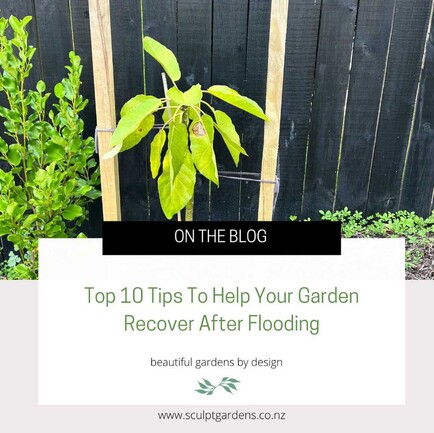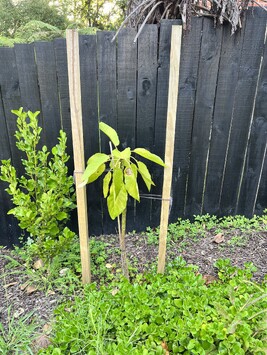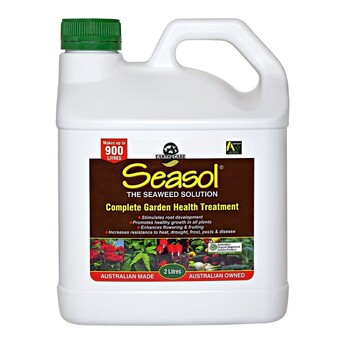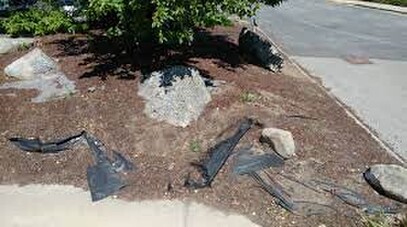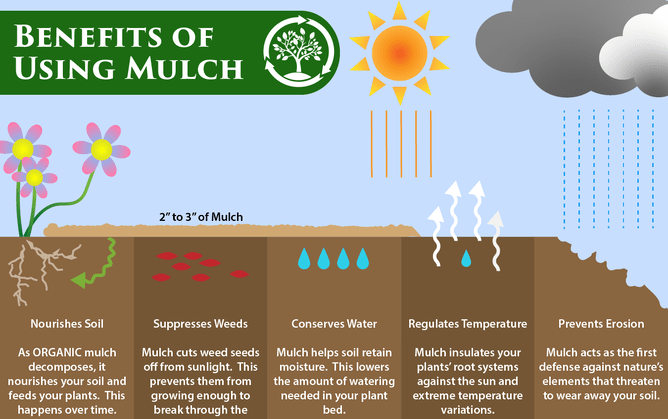The recent floods have left many of our gardens looking the worse for wear - damaged trees & shrubs, washed away soil & mulch and sad looking lawns. Clients have been asking the team at Sculpt Gardens what can be done to help nurture their gardens back to life after these extreme weather events.
You can tell that your garden is waterlogged if it is squishy underfoot. Excess water in the soil kills the plant’s delicate feeder roots, which are needed to intake water. This means that the plant is unable to take up water - it is crazy that excessive water leads to plants dying from lack of moisture. This is why the symptoms of giving plants too much water are the same as not enough.
Excessive moisture and waterlogged soil can kill plants. Symptoms include yellowing or browning of leaves, wilting and rotting trunks & branches. To help support plants, good soil health is essential. The upper soil layers & mulch may have been washed away over these floods, exposing a clay pan of hardened ground.
Before you rush out to replace your plants, it is worth taking the time to build up a new healthy foundation of soil. New plants will not flourish in a soil devoid of nutrients & organic matter.
Here are the 10 things you should be doing to help plants that are looking stressed & unhappy
1 / Clean Your Plants
If your garden was flooded to the point where your plants were covered in a layer of mud or silt, the first thing to do is remove this from the leaves. Your plants wont be able to photosynthesise if their leaves are still dirty.
If you have access to a power washer or a water blaster with a low setting, then we recommend washing off your hardier plants and trees. For the more delicate shrubs, hand wash the leaves with a hose and wet towel.
After you have cleaned as much mud off as possible, it is important to let your garden beds rest for a while. By adding more water to the soil in this cleaning process, walking around on your garden will only compact the earth further. This is a good time to rest and plan your next move.
Note: Be careful when removing anything that was brought into your garden by the surge. There can be lots of sharp objects and contaminated items, so dress appropriately!
2 / Prune to Preserve Energy
Firstly you can give your plants & trees a delicate prune. Most plant’s can handle being pruned by a third but be more careful than usual. This reduces their size and therefore the amount of water and nutrients they need. You should also cut off all flowers so that the plant’s energy is directed into growing new roots instead of flowers.
3 / Restore the soil, reinvigorate your plants - ORGANIC MATTER
Soil microorganisms such as fungi and bacteria are indispensable when it comes to soil & plant health. During flooding & heavy rain, these are destroyed & washed away leaving soil devoid of the beneficial microbes needed for your plants to grow, survive & fight disease.
The best way to add microbes back into your soil is through homemade compost but if you don’t have access to homemade compost, or your compost pile was flooded, here are the ways you can add these vital elements back into your soil.
To add organic matter, add a layer of new compost over your soil. If you do not have a dog, scatter sheep pellets through the garden bed or seaweed granules if you do. Even better gather seaweed from the beach and lay onto your garden beds between your plants.
Most compost products found in garden centres have been sterilised and do not contain live micro-organisms. See if you can find organic compost which contains live microbes.
4 / Restore the soil, reinvigorate your plants - MICROORGANISMS
To add soil microorganisms back into the soil, we use a product called EM1 (Effective Microorganisms) concentrate. EM1 is a natural probiotic for plants and soils, which increases the beneficial microbes & revives the soil’s ecosystem. EM1 interacts nicely with Seasol, a seaweed based plant tonic, so use both in a foliar drench. Add the products into a watering can and pour over each plant or water directly into the soil at the base of larger shrubs and trees.
5 / Fight Fungal infection & disease
Waterlogged soils create the perfect conditions for a range of fungal infections, which can be extremely harmful to your plants. If your plants start to look rusty or black spots start to appear, it is important to start spraying them with a fungicide.
Weak plants are also very prone to insect attacks & disease so keep an eye out. The EM foliar drench will offer protection against insect infestations & increase the plant's resistance to disease too.
6 / Light Watering
It is also important to point out that if the flood is proceeded by dry days, you must give your plants a light water. You might feel a bit silly in doing so but it is essential. The root damage caused by the flood means that your plants and soil dry out faster. This is why the leaves look wilted.
7 / Remove Weedmat
If you had weedmat on your garden beds, now is the perfect time to remove it. One of our most read blogs is 'Should I Use Weedmat In My Garden, which details the negative effects of putting a layer of plastic on top of your soil.
Over time weed mat kills the living organisms in the soil and creates an anaerobic dead layer of compacted earth. This stops the plants from thriving and prevents you from feeding the soil. When weed mat is put on top of clay, which is the predominant soil on the North Shore, Auckland and then pebbles or mulch placed on top of that, the soil becomes compacted and hardened. This causes anaerobic and waterlogged conditions during wet conditions, which can lead to root rot and struggling plants.
So, for the health of your plants and the soil, we strongly advise not to use weedmat in your garden beds, but replace with a thick layer of mulch. Which leads us to.....
8 / Remulch
Once you have fed the soil and added new compost, it is important to add back the layer of mulch. Mulch not only suppresses weeds but it also breaks down to add organic matter back into the soil. We use natural untreated 'bark mulch' or 'forest floor' mulch available from Central Landscapes. Mulch should be laid ideally 10cm thick.
9 / Tend your Trees
Trees are important features in our gardens, they can be used as statements, privacy and shade. Therefore it can be devastating to lose one. Take extra care with your trees after a flood as they can often only start to show signs of stress months after flooding has occurred. We recommend restaking them and pruning off any damaged or dead branches. Even if you see no obvious signs of damage we recommend you add some compost at the base and give them a weekly water with the liquid solution of Seasol and EM1 around the base.
10 / Right Plant, Right Place
As many of us worry that these extreme weather events might become more frequent, notice those areas in your garden that have become waterlogged. Which are the trees & plants that have quickly succumbed to these wet conditions? It might not be suitable to replace them with the same variety. Maybe a plant that is more hardy to the wet areas in your garden would be better suited?
If you think this might be the case, the team here at Sculpt Gardens would be happy to pop over to give some advice on alternatives.
